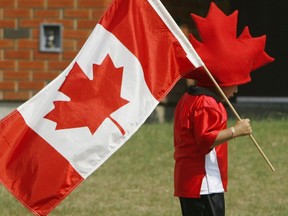Increased immigration not the solution to get Canada out of the world’s ‘ultra-low’ fertility club, say academics
Article content
Canada’s population has grown by a staggering amount in recent years, but babies have not been at the heart of the boom.
Statistics Canada revealed last week that 2023 was the second year in a row that Canada’s fertility rate hit an all-time low. The nation’s total fertility rate — a figure, based on current fertility levels, to determine the number of children a woman would be expected to have throughout her reproductive life — is at 1.26, down from 1.33 in 2022.
Advertisement 2
Article content
The lowest mark comes in British Columbia, where the rate plummeted to one, meaning women in that province, if the trend continues, are likely to have a single child.
“That’s quite a distance below replacement-level fertility of about two births — enough to replace mom and enough to replace dad,” Don Kerr, a professor and Canadian demographic researcher at King’s University College in London, Ont., told the National Post.
Replacement-level fertility is the rate needed to sustain and stabilize the population from one generation to the next. The United Nations puts it at 2.1, a benchmark Canada has not achieved since the early 1970s.
Total fertility rates hit unprecedented lows elsewhere in Canada, too. Also coming in below the Canadian average were Ontario (1.22), the four Atlantic provinces — New Brunswick (1.24), P.E.I. (1.16), Newfoundland and Labrador (1.08) and Nova Scotia (1.05) — and the Yukon (1.01).
Western Canadian provinces, while slightly above the national average, are also declining. As is Quebec, the province StatCan said earlier this year has done the best job of bolstering its rate via “expansion of family-related policies in the province.”
Article content
Advertisement 3
Article content
Nunavut, at 2.48, is the outlier across Canada, with its rate attributed to a lower average age of mothers there, more of them having more children and historically higher fertility rates among Inuit people, which make up the bulk of the population.
“Ultra-low” club
Statistics Canada noted that dipping below the 1.3 children per woman mark puts the nation in what’s known as the “ultra-low” or “lowest-low” club for fertility rates.
It’s joined by G7 partners Italy (1.25) and Japan (1.2), along with South Korea (.72), which has the world’s lowest rate. Even China, which instituted a one-child policy in the 1980s and is now grappling with a declining population and low fertility, counts itself as a member.
However, unlike China, Japan, Italy and others in the dubious club, Canada’s population is increasing.
“We’re in this really strange situation right now whereby we have record-high population growth. And at the same time, we’re not having kids, we have record-low fertility,” Kerr explained.
“That’s a strange situation for any country to be in.”
Babies and bills
The why behind dropping fertility rates, not just in Canada but also in other economically developed countries, is multi-faceted.
More women prioritizing careers and choosing to have children later in life has been a common and well-documented factor since the decline began in earnest in the 1970s, but in more recent years demographers and population experts suggest cost of living is a chief concern.
Advertisement 4
Article content
“Affordability questions, especially the cost of housing and thus the need to have two incomes to establish a middle-class standard of living,” Roderic Beaujot, professor emeritus in sociology at Western University, told the National Post in an email.
Beaujot said it’s also becoming increasingly normal for people to have one or no children.
“Not having children was once considered selfish, but now it can be justified as supporting ecological sustainability.”
Kerr, meanwhile, raised a hypothesis first formulated by U.S. economist Richard Easterlin during the baby boom of the 1960s, as a possible explanation. Easterlin suggested that a young couple’s likelihood of having kids is connected to relative income.
“By relative income, he meant the disposable income that young adults have relative to what they expect given their parents’ standard of living,” explained Kerr.
“They want to have that lifestyle that their parents had, they want to have that nice three-bedroom detached home in the suburbs. They can’t afford that, they’re frustrated and they’re putting off having kids or they’re deciding to have a dog.”
Advertisement 5
Article content
Low fertility fallout
StatCan’s latest number, Kerr reminded, is just a projection.
Still, the agency said earlier this year, it would seem fertility rates for Canada’s youngest cohort of women are “on track to complete at a lower level than that of previous generations.”
So, what are the consequences of a continued downward trajectory?
Of paramount concern is how it lends to Canada becoming older on average. An aging population, as has already been witnessed in more rural parts of the country, can lead to challenges in the labour market and put added pressure on health-care and pension systems.
Kerr also warns of how it might affect family networks.
“You rely upon family for economic support sometimes, usually from parents to kids, but not necessarily that direction, and it’s also emotional support on a day-to-day basis,” he said. “Older folks often rely upon one of their children to help out a bit right.
“Into the future, we’re going to have more population aging than anticipated and our family networks are going to be smaller.”
Reversing the trend
Both Kerr and Beaujot said Canada has been doing the right things to address fertility and make it more affordable and a little easier to have children nowadays.
Advertisement 6
Article content
They point to the Canada child benefit, expanded parental leave, and subsidized daycare as initiatives that can help.
Kerr, for his part, is still waiting to see if those initiatives bear fruit.
“I haven’t seen much of an impact as of yet.”
The academics are also on the same page regarding immigration as an ineffective way to address low fertility.
“Immigration has been a positive for Canada, but we need to discuss how many is too low and how many is too high,” Beaujot wrote. ”In my view, the average post-war rate of some 7.5 per 1,000 population (or 300,000 in a population of 40 million) would be a good level.”
Kerr added that many of the newcomers are probably not at a baby-making stage of life, having just arrived in a new country and facing many of the same economic pressures as existing Canadians.
“They’re trying to afford a home, they’re trying to find something to rent, that’s reasonable and they’re not having kids either.”
Our website is the place for the latest breaking news, exclusive scoops, longreads and provocative commentary. Please bookmark nationalpost.com and sign up for our newsletters here.
Article content






